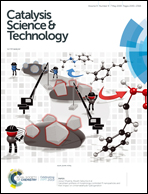Verifying the olefin formation mechanism of the methanol-to-hydrocarbons reaction over H-ZSM-48†
Abstract
The methanol to hydrocarbons reaction over a unidimensional 10-membered-ring zeolite, H-ZSM-48, was investigated in the temperature range of 723–973 K. C3–5 olefins were the dominant products of reaction at 723 K. Multiple approaches (constant, transient, co-feed and isotope labelling experiments) have been adopted to clarify the underlying reaction pathway. The results indicate that both of the olefin- and aromatics-based cycles contribute to light olefin formation, and the aromatics-based cycle can be significantly enhanced with increasing reaction temperature. Ethene is formed predominantly from the aromatics-based cycle while propene and higher olefins are mainly derived from the olefin-based cycle. The 12C/13C-methanol isotopic switching experiments manifest that hexamethylbenzene is the most active aromatic intermediate. Co-feeding of 13C-methanol and 12C-benzene at 543 K reveals that the paring mechanism is the dominant mechanism for aromatic dealkylation. More importantly, the first experimental evidence that the two carbons of ethene are derived from aromatic ring carbons is obtained based on the isotopic pattern. Furthermore, the investigation on coke-covered H-ZSM-48 reveals that the reaction of methylbenzenes occurs mainly inside the channels. This work will shed new light on the reaction pathway of the MTH reaction over unidimensional zeolites.



 Please wait while we load your content...
Please wait while we load your content...